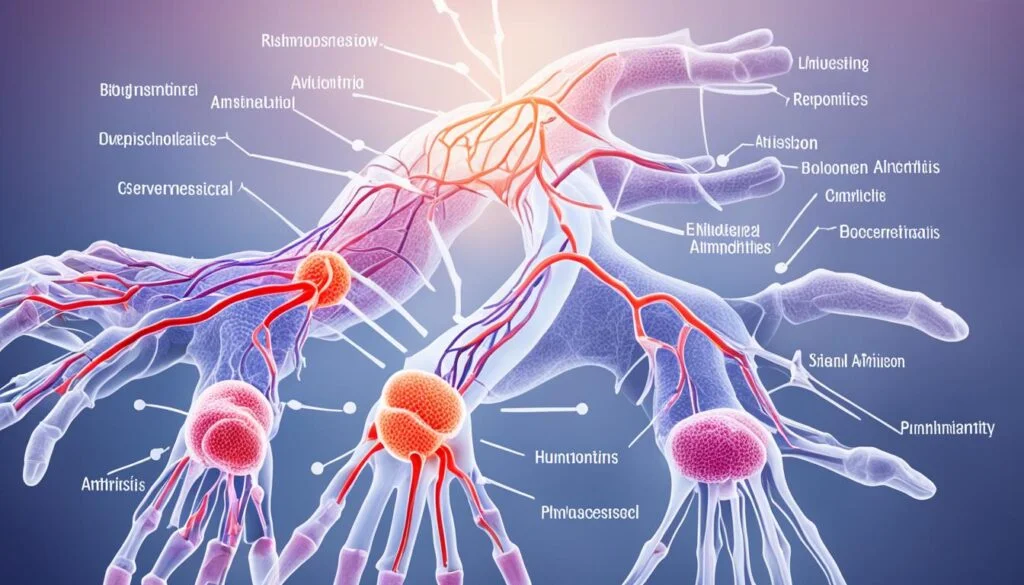Rheumatoid arthritis (RA) is a chronic autoimmune disorder that primarily affects the joints, causing inflammation, pain, and stiffness. It is estimated that around 1% of the global population is affected by this condition, with women being more susceptible than men. In this article, we will explore the causes, symptoms, and available treatment options for rheumatoid arthritis.

Section 1: Causes of Rheumatoid Arthritis
Rheumatoid arthritis occurs when the immune system mistakenly attacks the body’s own tissues, particularly the synovium, which is the lining of the joints. Although the exact cause of RA remains unknown, several factors are believed to contribute to its development. Genetic predisposition, environmental triggers, such as infections or exposure to certain chemicals, and hormonal imbalances are thought to play a role in the onset of rheumatoid arthritis.

Section 2: Symptoms of Rheumatoid Arthritis
The symptoms of rheumatoid arthritis can vary from person to person, but common signs include joint pain, swelling, and stiffness. The joints affected by RA are usually symmetrical, meaning that if one joint is affected, the corresponding joint on the other side of the body is also likely to be affected. Other symptoms may include fatigue, low-grade fever, loss of appetite, and a general feeling of malaise.
Section 3: Diagnosis and Treatment Options
Diagnosing rheumatoid arthritis involves a combination of medical history, physical examination, blood tests, and imaging studies. Early diagnosis is important to prevent further joint damage and improve the effectiveness of treatment. While there is no cure for rheumatoid arthritis, various treatment options aim to manage symptoms, slow down the progression of the disease, and improve the quality of life for individuals living with RA.
3.1 Medications:
Nonsteroidal anti-inflammatory drugs (NSAIDs), corticosteroids, and disease-modifying antirheumatic drugs (DMARDs) are commonly used to reduce pain, inflammation, and joint damage. DMARDs can help to slow down the progression of RA and preserve joint function.
3.2 Lifestyle Changes:
Making certain lifestyle modifications can also help manage the symptoms of rheumatoid arthritis. Regular exercise, such as low-impact activities and stretching, can improve joint flexibility and strengthen muscles. A balanced diet rich in fruits, vegetables, and omega-3 fatty acids may have anti-inflammatory effects. Additionally, stress management techniques and getting enough restful sleep are crucial for overall well-being.
3.3 Surgical Interventions:
In severe cases where joint damage is extensive, surgical interventions like joint replacement surgery may be recommended. This involves replacing the damaged joint with an artificial one, relieving pain and restoring joint function.
Section 4: Living with Rheumatoid Arthritis
Living with rheumatoid arthritis can be challenging, but with proper management and support, individuals can lead fulfilling lives. Support groups, counseling, and occupational therapy can provide emotional support and assist with adapting to the changes caused by RA. It’s important to communicate with healthcare professionals, follow the prescribed treatment plan, and stay informed about the latest advancements in rheumatoid arthritis research.
Conclusion:
Rheumatoid arthritis is a chronic autoimmune condition that affects millions of people worldwide. Although there is no cure, early diagnosis and appropriate treatment can help manage symptoms, slow down the progression of the disease, and improve the quality of life for individuals living with RA. By understanding the causes, recognizing the symptoms, and exploring the available treatment options, those affected by rheumatoid arthritis can take proactive steps in managing their condition and achieving a better quality of life.


Pingback: Rheumatoid Arthritis rheumatoid arthritis symptoms